Three more days in Italy (this time with feeling)
Pain, more pain, martyrdom and beauty: impressions of stages 16-18 of the Giro
DISCLAIMER: Most of this was written on Thursday. Make of that what you will.
Image credits: As usual, they are a collection of terrible photographs of my laptop screen, you’re welcome.
I don’t recall agreeing to write about every stage of the Giro this year, at least publicly. After explaining my situation in my first post about the race, I figured I’d keep notes of each stage anyway, and this turned into protracted race reports and observations, of which this post is now the fourth – and penultimate. The promise I made may not have been made publicly, but it’s there, itching away at the back of my conscience, so, here we are. It seems I just can’t NOT write about a Grand Tour.
Squeezing in the writing around other work and – y’know – actually watching the race unfold and keeping tabs on it as I go along, is kind of brain-scrambling. Especially when you consider how much has happened across two of the last three stages. Picture this: the last time I posted, Roglič was still in the race, UAE were still embroiled in a leadership wrangle, second place on GC was almost a minute-and-a-half down on the race leader, and Lorenzo Fortunato only had 197 mountains points (for context, today, after stage 18, he has 355. And he hasn’t even won any today.
Some other things have happened that have struck blows to the soul of this soft-hearted cycling fan: Roglič’s painful honesty, and his subsequent withdrawal from the race. Josh Tarling’s crash on a wet roundabout, that drenched me in cold dread for a few horrible moments; the fact that Romain Bardet still hasn’t won a stage, despite coming oh, so close.
Yet in amongst all these blows, the blooming of a GC battle the likes of which I don’t recall seeing before – not in the ways of its intricacies and what-ifs and unknowns. More beautiful breakaway victories; vindication for some, and painful departures for others.
And the fulcrum on which all this madness teetered: stage 16. The first day back, after the final rest day. A day which filled all available time, and brain space, and took up more besides, overflowing with its overlapping storylines, as battles were waged concurrently at the front of the race, and further down the road.
Stage 16: The difference-maker (part 1)
It was the longest day, a cycling solstice if you will.
I don’t know if a person has ever taken longer to watch a Grand Tour stage. Or if more has ever happened in one Grand Tour stage. These facts are inextricably linked, of course – if I’d been as busy as I was that day, on a flat sprint stage, it wouldn’t have been an issue. I’d have merrily skipped through, checking I didn’t miss anything major, and been up to date before dinner time.
Instead, I went to bed with 45km still to watch. Having avoided social media all day. I accidentally opened my emails to see the name of the winner, in the press release from the Giro, and was irrationally annoyed with myself. I consoled myself with the fact that this stage was always going to be big. Pivotal. Perhaps even decisive. The winner was just one piece of a far more complex puzzle, one that needed to be taken in moment by moment – a four-dimensional jigsaw.
Let’s go back to the beginning. Even before the stage, Primož Roglič foreshadowed the end of his race. He was still on the bike in body, but not in spirit, as he offered up one of the most un-Roglič-like pre-race interviews – or perhaps the most brutal version of himself laid bare; one which we haven’t seen before. He said he didn’t see himself as a GC contender anymore, and couldn’t even ride on rest day. Stage 16 was simply a test of whether he could continue on his bike at all.
Isaac Del Toro was pragmatic, deploying metaphors in place of a straight answer, when quizzed on the team leadership: ‘if something happens to me, we have more bullets to use in the team.’ He’s been well-trained, it seems/
Somebody somewhere predicted, based on the parcours alone, that this Giro was going to be underwhelming. Eschewing most of the truly iconic Italian mountain passes – no Stelvio or Pordoi. No Fedaia or Blockhaus or San Pellegrino. The Mortirolo and Finestre were in, but summit finishes out of fashion. Whoever downvoted the route, would be quietly retreating from view by the end of this stage. It was actually on paper the hardest final week of a Giro since 2000, and with the greatest number of altitude metres ahead of them, any sprinters sticking around for their final chance in Rome were to be applauded. The grupetto would be in full swing early on in the day, and not all of the sprinters wanted to hang around and take their chances. Two debutants, Milan Fretin (Cofidis) and Paul Magnier (Soudal-QuickStep) waved goodbye after the second rest day – and who could blame them. Anyone on form at the beginning of the race would be regretting mis-timing their peak fitness – riding into the race would be more important than ever.
Week 3 began in the rain, ahead of a day with nearly 5,000m of altitude gain and over 200km. The fatigue was real. Seeping into the bones and under the skin. And that was just me, preparing for a day in front of the laptop screen, weathering the storm vicariously.
On the Never Strays Far podcast, Ned Boulting spoke to a member of the Giro organisation, who compared pro cycling to Catholicism, replete with pilgrimages and punishment. If there was ever a living, breathing version of the stoic martyrdom of the professional cyclist, Gianluca Garofoli was it. The Soudal-QuickStep rider had been pictured crying in the arms of his girlfriend at the end of stage 15, having almost managed to stay with eventual stage winner Carlos Verona. The experience and power of the Spaniard proved too much in the end, and it later transpired that Garofoli had been making those herculean efforts with three broken ribs. If that weren’t enough self-flagellation, he was immediately on the attack on stage 16, as a mammoth breakaway battle ensued, many riders with something to prove, or desperate to claw back some prize from a race that had thus far eluded them.
Garofoli proceeded to crash once again, his wheel slipping from beneath him, his body clattering to the tarmac and sliding across the road. Still, he climbed back on his bike and attacked. Was he brave, or foolhardy? Or so full of adrenaline that the pain didn’t even register? Whatever the answer, watching his almost unhinged attempts to get into the day’s break despite his compounding injuries was grimly compelling.
INEOS suffered, with first Thymen Arensman, then Josh Tarling crashing - the latter appearing seriously hurt - and they would not be the last of the riders to take a tumble on this most dramatic of days. Later, a nasty crash for Bardiani’s Alessio Martenelli on a slick, wet descent had my heart racing. He was later reported to have fallen into a ravine, bringing sickening memories to mind. He is OK. Conscious, stable, and lucid. Thank the stars. The miracles that pro cycling produces on a semi-regular basis are simultaneously astounding and unbearable.
After relentless attempts, a chasing group finally detached itself from the bunch and with UAE taking control, they were allowed to depart, and began to work their way into the gap to the head of the race. They eventually joined the previously established six-rider lead group on the first categorised climb of the day to form a 24-strong breakaway, with a gap in excess of six minutes, and over 128km still to ride.
After this, 2.5 pages of notes remain – just for stage 16. My obsessive need to document races led me to try and keep up with every move, every attack, all the notable ‘stuff’ that occurred. To try and pick a coherent, chronological storyline out of the reams of information now, three days later, feels ineffectual. It was a day of racing that defies being condensed down into a dry summary, demanding attention for its entire duration. Yet writing the blow-by-blow account in cold, hard facts still doesn’t do it justice.
The gap to the break goes out to over nine minutes as peloton exercises caution on the descents. In the lead group, Dries de Bondt chats good-naturedly with Lorenzo Forunato and Wout van Aert and mimes shooting himself in the head – an accurate representation of the pursuit of the irrepressible baroudeur who’s not built like a climber, in a breakaway on a climbing stage.
Then the news we half expected broke – Roglič and Carapaz crashed together somehow – there was no footage pf what happened, but where Carapaz could pick himself up and ride on, Roglič finally surrendered to the cruel whims of karma and stepped off the race, his third fall proving one too many for the stoic Slovenian who will once again refocus on the hexed race of his career – Le Tour.
A nasty little traffic island not adequately signalled claimed two more victims, though they both got up and looked to be OK – one of them Sunday’s stage winner, Carlos Verona.
The push and pull in the peloton began, as UAE - with one leader below par and another untested - were content to let the gap grow out, so they were ousted from the driving seat by INEOS, the bullish Ben Turner taking two minutes off the gap by himself as the British team scented blood in the water – Juan Ayuso isolated over a minute behind the main group. UAE took revenge a short while later as Egan Bernal hit the deck – a seemingly innocuous crash, but a chance for the race leaders to exact punishment for a perceived wrong, perhaps – they took their turn to push the pace, before later easing off once again. They had no need to exert pressure, over either their nominal leader Ayuso, who was clearly not himself, or their eager understudy Del Toro – the young man would have enough to contend with later in the day, not to mention the rest of the week.
Another faction threw in their lot with the push and pull, Red Bull taking over as it seemed they would shift focus to their young climbing domestique Giulio Pelizzari after the loss of their leader – the young rider who had shown his mettle the previous year, riding for Bardiani, raw talent on display yet eclipsed on the Mortirolo by the rampant charge of a Pogačar on a one-man mission to crush the race in the palm of his hand.
As the breath-taking backdrop of lakes and castles passed by, the race reached the penultimate climb of the day, and the breakaway fractured once more – the continued woes of David Gaudu as he fell out of contention were starkly contrasted against Lorenzo Fortunato’s relentless pursuit of excellence, as he set off in search of even more KOM points, in a competition that he’s made his own with verve and panache.
The next to the party in the peloton were EF Education-EasyPost, and they found allies in first Visma, then INEOS – an anti-UAE alliance that sensed the race could be won or lost over the next two peaks. And so it proved, for Juan Ayuso at least. With Roglič down and out, the final nail in the coffin of Ayuso’s GC hopes was struck on the slopes of the Serrada, as up front, Del Toro held on – UAE had said the roads would decide. And the hammer had fallen. Tudor Pro Cycling were up next in a rotating display of potential race winners, and to see the belief of all these teams in their leaders despite the deficits at the beginning of the day was to watch a different kind of cycling: one which has ostensibly been crushed under the dominion of Pogacar and Vingegaard: one in which hope exists, and belief in the ability of a team other than UAE to shape the race in the way they would like – Michael Storer took his chance to launch, Max Poole accompanying him.
Those who could hold firm did so, as many dropped in their wake. Bernal was briefly among them, though he made it back on, the GC group slimmed down to just the leaders, with domestiques all falling away. Del Toro stayed steady, and Simon Yates appeared strong. The breakaway was reduced to seven intrepid hopefuls: Fortunato, Pello Bilbao, Cristian Scaroni, Yannis Voisard, Gijs Leemreize, Jefferson Cepeda, and Sylvain Moniquet.
Voisard attacked on the descent – Tudor having a good day on all fronts – as at the front of the GC group, Wout van Aert arrived, a waiting satellite for Simon Yates, rolling back the years as it brought to mind his interminable work for Jonas Vingegaard at the Tour de France.
Onto the final challenge of the day, the Monte Bondone – 21km of hanging on for grim death, or rising to the occasion. Astana have been rising to meet their considerable challenges head-on all season, and the pairing of Fortunato and Scaroni went about attacking the finale of this race with the same spirit, with Cepeda for company.
After lending his weight to the procession up the climb for a good while, Wout clocked off around halfway up with 11.7km to go and Rafal Majka took back control for UAE, but it was to be a day for Italians to take action – almost at the same moment, Pelizzari launched from the GC group and Scaroni from the front group, as the gap reduced to 3:30 and continued to fall.
Behind Pelizzari, a ‘last man standing’ style of GC battle began, as Yates attacked – Del Toro and Carapaz matched him, Derek Gee joined the party. The first true test of Del Toro’s mettle had begun. It was Richard Carapaz who would strike the killer blow. The Ecuadorian moved with just over 6km to go, opening a gap, and Gee tried to follow as behind Yates and Del Toro marked one another, with Storer dropping back from his foray up the road to join them.
Three kilometres later, it happened. Del Toro cracked. It had seemed inevitable and yet perhaps we’d all come to believe, that he would prove unshakeable. So it still came as a surprise. Carapaz displayed his characteristic grit, as the realisation hit that we really had ourselves a race, the whole picture shifting before our eyes like a magic eye picture ahead of more mountain tests to come. When Bernal clawed his way back to Del Toro I’m not going to lie: I had actual chills. Each man waging his own personal war with his body, and the gradient, all sense of who was where - both on the mountain, and in the shifting sands of the GC standings - given up in favour of survival, every man for himself: and the man at the top was Carapaz.
It was enough that I briefly forgot all about the Astana pair at the head of the race, quietly going about winning the race and the maglia azzurra – a beautiful, supreme ride from the pair of Italians, who crossed the line hand in hand, Scaroni the stage winner, Fortunato winning hearts and minds, along with putting the KOM competition out of sight. It was the first Italian stage win in 17 stages.
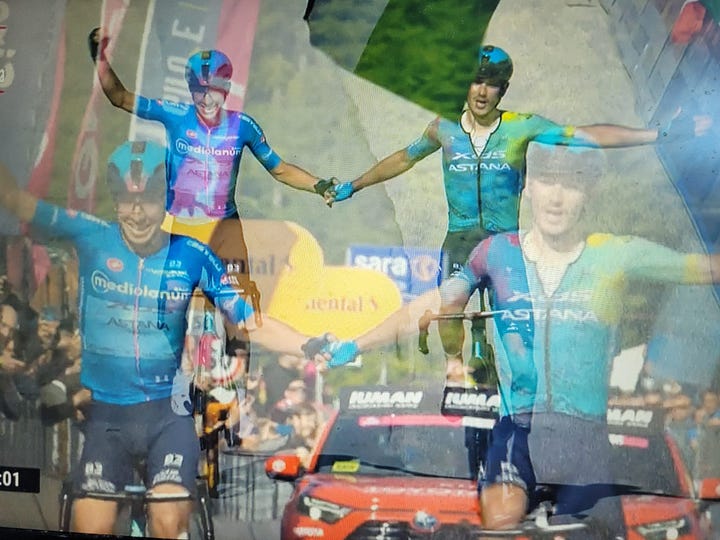
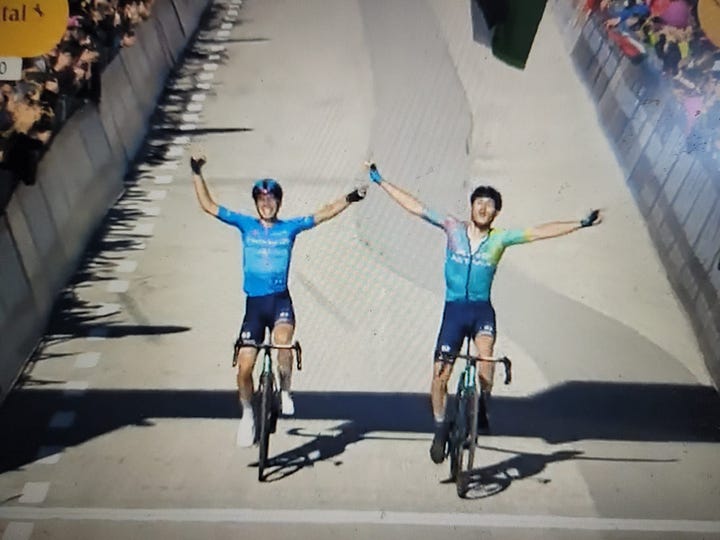
As they neared the finish, Pelizzari stormed away from Carapaz, to round out the podium – the first 1-2-3 for Italy since 2016.
Yet it was a victory in miniature as the EF rider crossed the line in fourth, Gee following in fifth, mouth hanging open with the effort. Cepeda from the break was sixth, proving, with Storer and Yates taking next places – as behind Bernal, Del Toro came out swinging, teeth gritted – it wasn’t a capitulation from the youngest man to lead the Giro this century, not by a long chalk; his race not lost, but his campaign dented.
I have never been so excited to look at a GC standing. With pre-race favourites eclipsed and out of the picture, a whole new race ignited. Ayuso rolled in over 14 minutes down, as it was confirmed that Del Toro would retain the maglia rosa – but Carapaz and Yates both edged perilously closer behind him.
I wanted to write about every stage. Yet with kids on school holidays and other work commitments, watching the race at all became a challenge. My diligent note-taking drifted into a few quick points on the breakaway formation following by a yawning chasm of ‘THEN SOME STUFF HAPPENED’ while I juggled life’s many balls (stop it) and just tried to grip on for dear life.
Stage 17 was a bit shorter, and it was expected to be explosive. It was Mortirolo day, for goodness sake!
The strange, seemingly pointless De Bondt versus Pedersen intermediate sprint battle went the way of the Dane (because of course it did), punctuating the strung out breakaway shenanigans, which continued on after with no resolution and splits aplenty. When a break finally did go it was pretty much a peloton in its own right, consisting of 28 riders, including strong contingents from Visma, Red Bull, Astana and Decathlon.
The group was too big to hold together and it burst at the seams on the day’s early climb, as behind, the peloton was driven by – of all teams – Polti-VisitMalta (the typo in my notes made it read ‘Polit’ – which is usually true. Spooky).
As they hit the Mortirolo the sharks were circling once again, with EF, INEOS, and Tudor all amassing at the front of the race. Tiberi became one of the first victims of the Mortirolo, as it seemed Bahrain would shift focus to Caruso’s quest to push up the standing.
Lorenzo Fortunato and Chris Harper pushed toward the summit as more riders were dropped from the lead group, and Dani Martinez tried his luck while his teammate Pelizzari and launched from the GC group with. Del Toro hung on at the back.
Rather improbably after all of those attacks, it was Bahrain’s Afonso Ulalio who struck out to win the KOM, while behind, Carapaz stuck an attack and began to put some time into the rest. Del Toro briefly lost contact but clawed his way back once again.
With 20-something kilometres remaining, there was a regrouping both in the lead group and the bunch, around 1:45 behind. The stage hung in the balance and the GC was seemingly at stalemate.
As they closed in on the final climb, the gap began to fall rapidly, below a minute for the first time, Damian Howson turning himself inside out for Tom Pidcock, who hasn’t gotten anything out of the race yet and was clearly feeling good. By the time the slopes began, it was under half a minute, with UAE leading in numbers and EF in close quarters behind.
Florian Stork was riding hard at the head of the race with Romain Bardet trying to stay with him. I declared that if Romain Bardet didn’t win a stage of this race, I’d riot. But in a way that the eloquent Frenchman would approve of: in writing. Today looked like it was going to be his day. He launched.
Martinez gave his last-ditch effort for Pellizzari having dropped back and the group slimmed down again; with Martinez done, all the top riders were isolated.
Bardet was leading the race solo – could it really be the day? I realised I needed this. I really needed this.
But Del Toro attacked! Carapaz stuck to him like glue and the pair closed Bardet down, forming a lead trio. It held until 1.5km to go, when Del Toro found space, and a new lease of life. The young pretender sprinted clear of the seasoned pros – a turn-up for the books, given he was almost dropped a couple of times on the stage. A truly gutsy performance, that earned him bonus seconds as well as a well-deserved stage win.
He even celebrates like Pog.
Of course it was hollow. Heartbreak for Bardet fans. Ie, me. He was undone by the race’s rising star. His final shot at glory in a Grand Tour extinguished; the fairy tale ending cruelly ripped from the end of the story of his career. An agonising, oh-so-close second place perhaps the perfect encapsulation of what it means to be a romantic, tragic French hero.
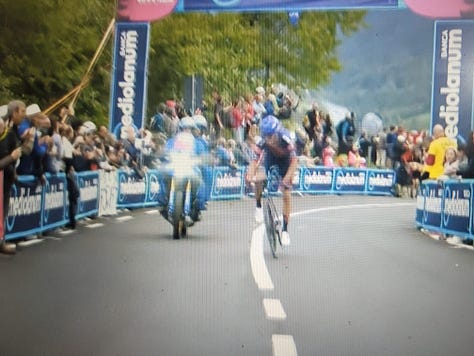
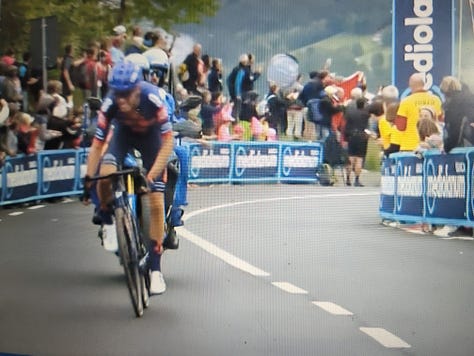
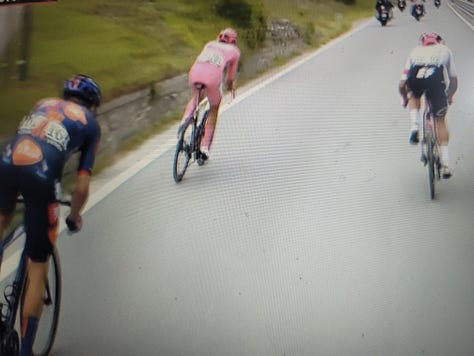
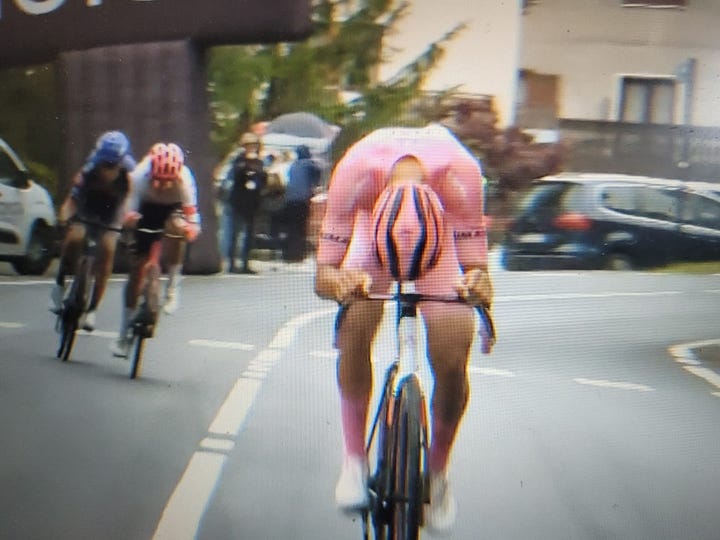
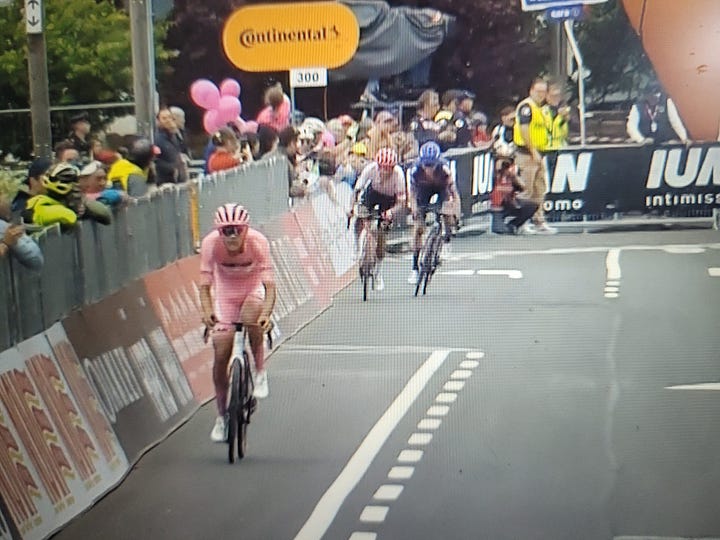
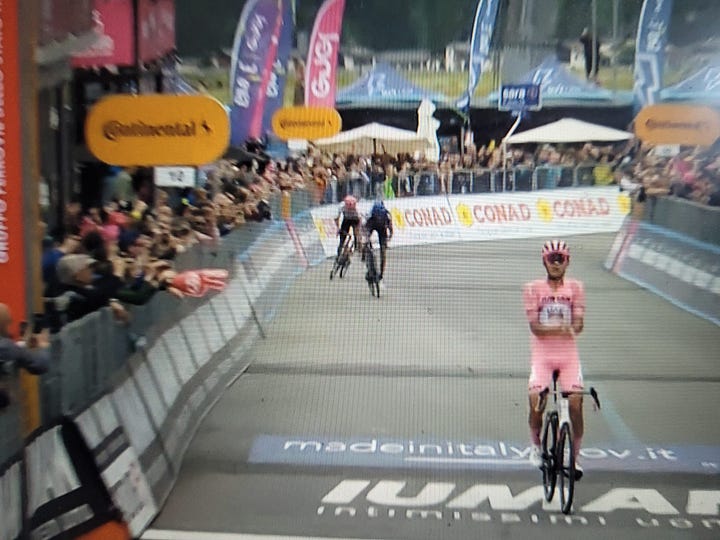

The holiday planning was back in full force on as stage 18 rolled out of beautiful Morbegno (let the record show that I had ‘??’ after ‘stage 18’ in my notes, a reflection of the state of my brain after almost a month submerged in a Grand Tour).
The endlessly hopeful Enzo Paleni kicked off the front again; there are always a handful of guys who seem to head out in the break almost every day at a Grand Tour, and Paleni is one of this year’s escape-artist extraordinaires.
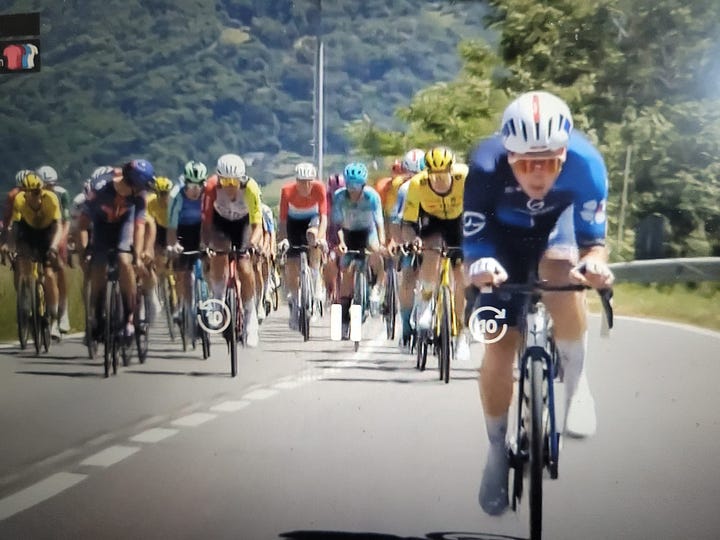
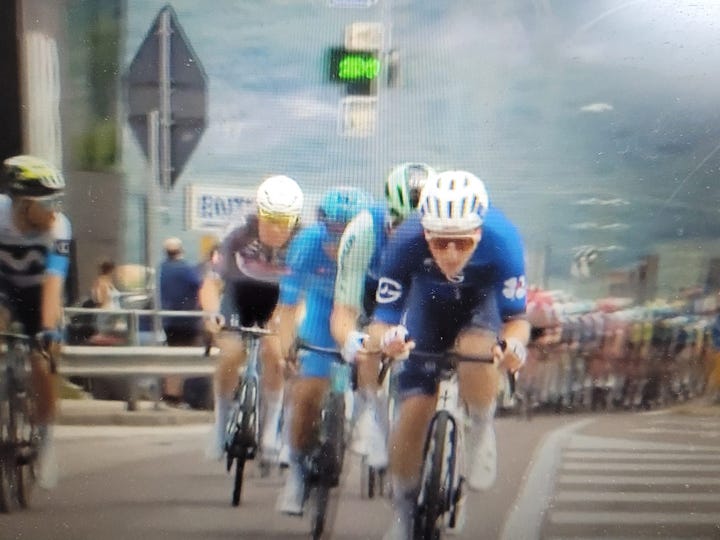
Some breaking away occurred and was thwarted. The peloton resisted a final settlement for a long time, the gap hovering around a minute, as the daily deja-vu of Pedersen beating de Bondt at an intermediate sprint came and went.
30-something riders went out in the break in the end, and with Pedersen, Groves and Van Aert present, and at least two sprinters out of the race, it pretty much killed the option of it going to a bunch sprint, and the gap ballooned to over ten minutes.
As for Juan Ayuso, he began the day with one eye swollen shut after being stung by a bee. Memes about Visma-Lease a Bike somehow being responsible abounded, but the end of the race came shortly after for the Spaniard. He climbed into the team car, perhaps a day or two too late, to move on to his next goals.
Up front, a trio of Remi Rochas plus two VF riders took off and got a gap, as the rest of the breakaway split under the pressure of new attacks. Van Baarle kicked off the next move, and a new group of around 11 riders succeeded in opening a proper advantage.
The final rider to attack and make it stick went on to win the stage. Nico Denz, striking out to try and win something for his beleaguered team following the losses of both Hindley and Roglič, leaving them rudderless. Denz built on his lead and the chase group took their foot off the gas and began to look at one another. There was talk of the peloton being lapped on the finishing circuit – the delightful chaos that may have ensued should that have happened remained theoretical, thankfully, as the fateful catch never occurred in the end. Nevertheless, Denz sealed the solo victory, two years since his last win, at the same race, to bring the score to 4-1 in favour of the breakaway, from the five most recent stages. Now THAT is what we love to see.
Yes yes. I know the race is basically over, and it seems hardly worth me saving my final thoughts for after today’s largely ceremonial stage in Rome. If you’ve been reading my other round-ups you’ll know I’m hardly one to delve into the minutiae of bunch sprint finishes.
This race absolutely warrants another full post though, after what happened yesterday (what the heck happened yesterday, am I right?!) and so that is what you will get. It may be late, inconsistent, and around 50% off-topic, but if that isn’t what you’ve come to expect from me by now, then you haven’t been paying attention 😉And anyway, have you SEEN the length of this thing? You need a break, even more than I do, before I bring you my scattered selection of final thoughts.
Thanks for reading if you’ve made it this far, you are all great and I love it here. More soon.
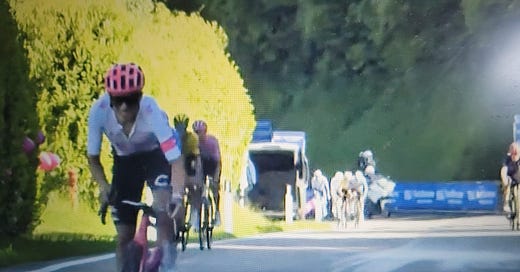




It’s now 5 days post Giro, and I’m still shaking my head as I digest so much coverage. Can’t wait to read your take on it too -“The Decider Part(s) -?”. PS: love your photo credits.
They said this was the hardest final week of a Grand Tour in years, and it’s certainly delivered in thrilling racing: I thought Stage 16 was one of the best stages in a GT in a long time but yesterday might just have topped it. And if you’re (a) from Lancashire, as I am and (b) watched in something close to awe as Froome ripped up the race and the rule-book in 2018, as I did, it was doubly if not triply poetic.